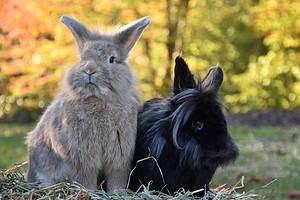Although you wouldn’t think of most rabbit breeds as exotic, these fluffy critters are technically considered exotic pets. So, before you invest in a bunny, it’s best to understand the upfront, maintenance, and lifelong costs of keeping a rabbit as a pet. Thankfully, in most cases, rabbits aren’t as expensive as other pets, but you’ll still need to keep some things in mind, like exotic pet veterinarian costs. Let’s check out pet rabbit costs so you can determine your best plan for bringing home a bunny.
How Much Does a Pet Rabbit Cost?

Initial costs for your pet bunny include adoption or purchase, setup supplies, food, and a few other things. But first, let’s look at the purchase of your new fluffy pal. Three basic ways to acquire a pet rabbit exist, including freebies, adoption, and breeders.
Freebie Bunnies
While not always available, bunnies occasionally may be acquired from owners who never got their rabbits spayed or neutered. Sometimes, the bunnies come from families who adopted a rabbit but discover the rabbit doesn’t fit their family for some reason.
The free rabbits may be listed on sites like Craigslist or rescue websites. If you find a free bunny, be sure to look into the living conditions the rabbit has lived in. This includes the diet and health of the other rabbits, as well as the cleanliness of the habitat. If they come from a bad situation, the rabbit likely will experience health conditions or behavioral problems. You may still wish to adopt the free bunny, but you may opt to look elsewhere if the other rabbits look poorly.
Rescue Shelters
From rescue shelters, you’ll likely find your new long-eared pal will cost between $20 and $70. Not all shelters keep rabbits – many are not equipped for them – but when they do, you’ll likely find a good choice for your family.
Breeders
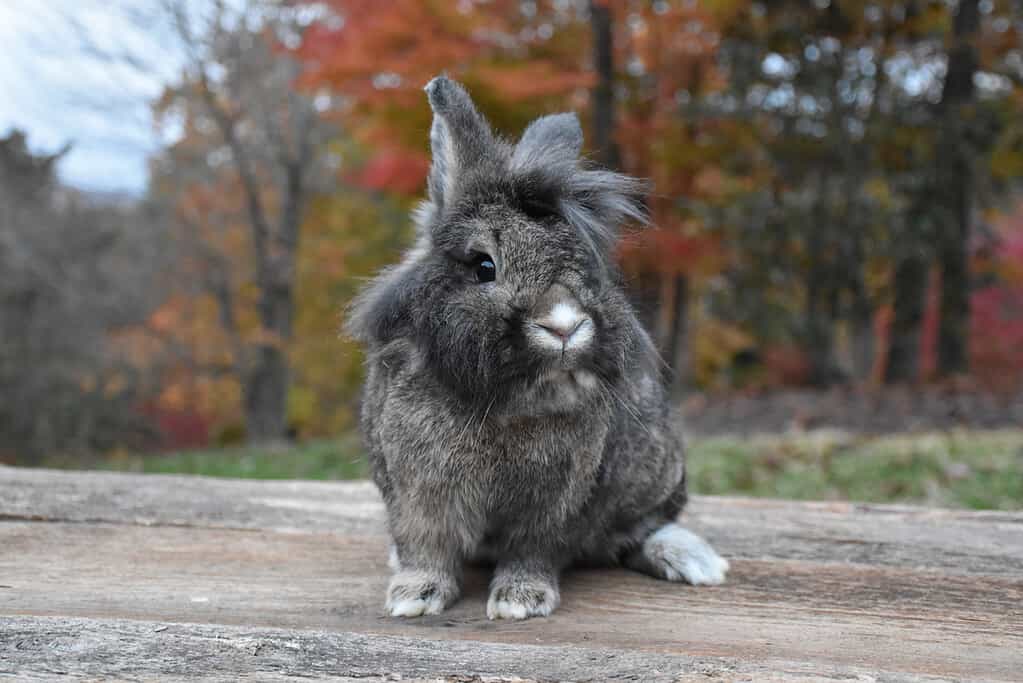
Adorable natural-colored lionhead rabbit sitting outside on an old wooden table.
©iStock.com/JudyN
Breeders are the most common source for finding the right rabbit. Rabbit costs from breeders will typically also run between $20 and $70 for common rabbit breeds. The rarer the breed, the higher the cost. Still, most rabbits won’t run more than about $100, unless you’re going for a show rabbit.
The reason rabbits are less expensive than other exotic pets is their quick breeding. Many others only breed once a year, while rabbits often produce multiple litters in a single year.
Of course, the breed also affects the cost of a rabbit. So, consider the breed you would like to bring home before buying.
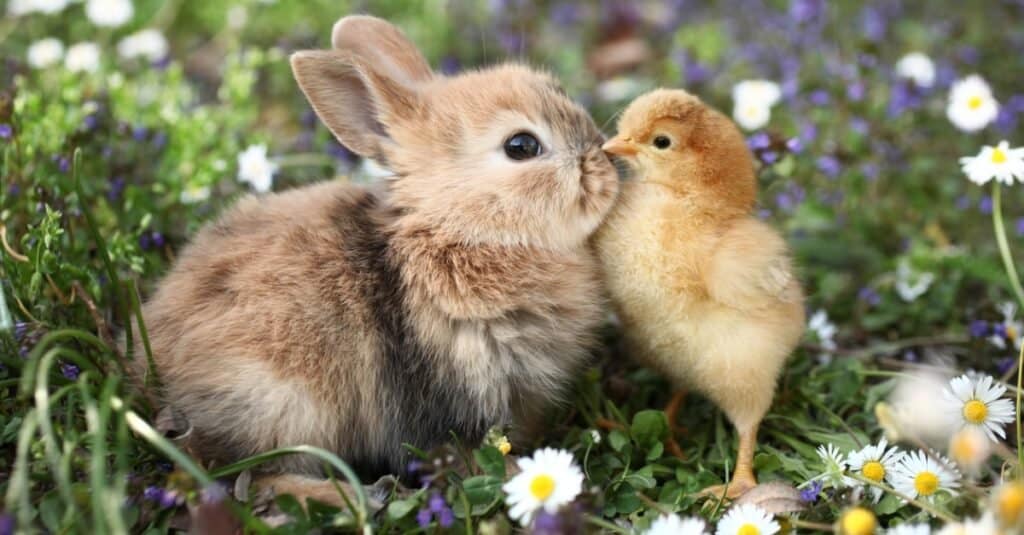
Often, folks buy rabbits as Easter gifts and give them to folks not ready to care for a pet. These may wind up in shelters or as freebies on the web.
©iStock.com/UroshPetrovic
Rabbit Cost by Breed – Lowest to Highest
Some of the most common breeds by cost, from lowest to highest.
| Breed | Low Cost | High Cost |
|---|---|---|
| Black satin | $20 | $20 |
| Silver fox | $20 | $20 |
| Chinchilla | $25 | $25 |
| New Zealand | $25 | $30 |
| American Rabbit | $30 | $50 |
| Lionhead | $30 | $180 |
| Californian | $35 | $80 |
| Flemish Giant | $35 | $150 |
| Mix Breed | $35 | $200 |
| Jersey Woolly | $40 | $50 |
| English Spot | $40 | $50 |
| Rex | $40 | $60 |
| Havana | $40 | $65 |
| Velveteen Lop | $40 | $70 |
| Mini Rex | $40 | $80 |
| Dutch | $40 | $85 |
| French Angora | $45 | $45 |
| Continental Giant | $45 | $90 |
| Dwarf Hotot | $45 | $125 |
| Cashmere Minilop | $50 | $50 |
| Cinnamon Bunny | $50 | $50 |
| French Lop | $50 | $60 |
| Neatherland Dwarf | $50 | $75 |
| Polish | $50 | $95 |
| Mini Lop | $50 | $400 |
| English Lop | $60 | $60 |
| Harlequin | $60 | $80 |
| Holland Lop | $65 | $150 |
| Mini Satin | $100 | $100 |
| American Fuzzy Lop | $175 | $200 |
| English Angora | $100 | $300 |
| Thrianta | $250 | $250 |
What’s the Cost of Insurance and Health Care for Rabbits?
Generally speaking, rabbits stay pretty healthy, if they are properly cared for. Some breeds may be more prone to disease than others, of course. The proper diet, maintenance of the grass hay accessibility, and regular exercise help keep them healthy and happy.
However, if there’s a chance your bunny could get sick. They’re prone to injuries and illness if their care declines or they are particularly energetic. They’re sensitive and not thought of as robust animals.
For those who avoid injury, vet visits will be infrequent. Others will, unfortunately, need more frequent care.
Consider the following costs for care of your bunny.
Spay/Neuter Cost
Not everyone opts to get their rabbit fixed, but if you don’t want to risk the possibility of other bunnies hopping around, it’s a good idea. Even more, getting your pal spayed or neutered can help prevent both behavioral and health issues.
The spay or neuter rabbit costs generally run between $125 and $250, depending on your location.
Health Insurance
While health insurance for pets doesn’t work the way it does for humans, it’s still a good idea to maintain some for your rabbit. Rabbit health insurance doesn’t come from many companies, but it’s still a good idea to look around a bit before buying. Most will run around $20 a month for a basic plan and could run up to $100 or more for the plans with more significant coverage that helps stave the costs of emergencies.
Regular Check-Ups
Part of the way you help your bunny stay healthy is through regular vet visits that check their health annually. Rabbits have chronic issues with their feet and teeth, so they need these regular checkups to ensure they’re not developing problems. These checkups usually run between $20 and $50 per visit.
Dental Care
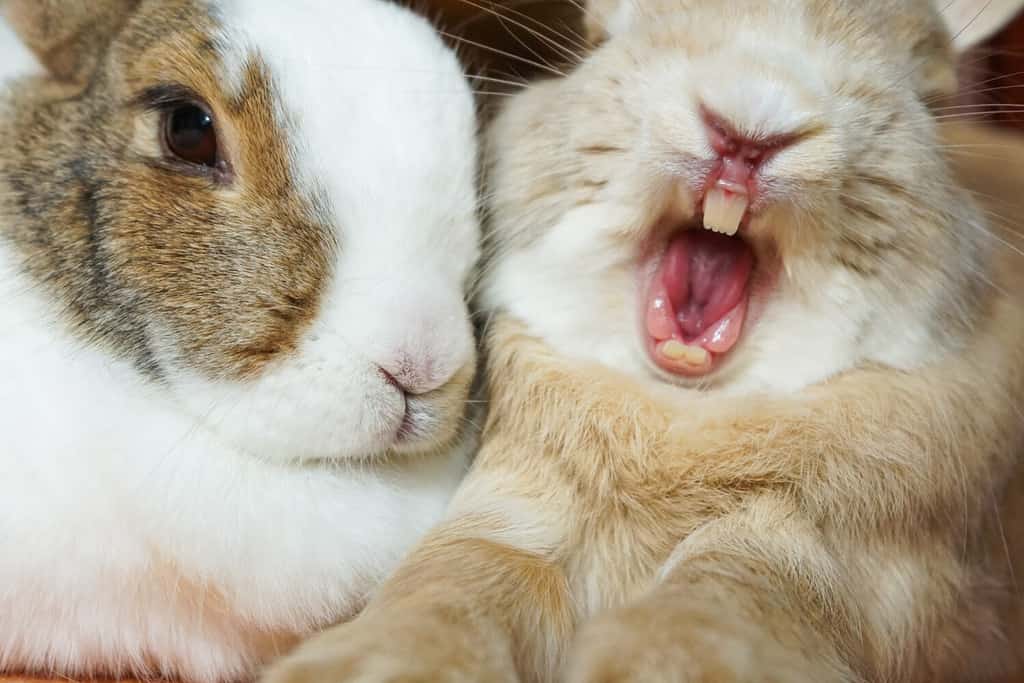
Oral health is a huge concern for rabbits, particularly since their teeth keep growing their whole lives.
©Thurid_with_th/Shutterstock.com
Because of their proclivity for poor oral health, regular dental care is required for rabbits. Their teeth continue to grow their entire lives, so need frequent trimming along with the proper diet. The tooth growth is part of why rabbits chew on everything as well, so reduce these costs by giving them plenty of toys to chew on.
Most dental visits for rabbits will run between $60 and $100, but if there are problems, they may cost as much as $300. Groomers usually charge less than vets, too, so you may be able to save some money there.
Parasite Treatments
Just like most animals, rabbits are prone to parasite infestation. The treatments tend to be expensive, but usually, the infestations can be kept away by proper treatments and regular checkups. Simple prescriptions usually deal with the issue but may run between $50 and $200.
Emergencies
Because rabbits tend towards injury and illness, emergencies may arise. These create the biggest potential cost for rabbits. Emergency care may run anywhere from a few hundred dollars or all the way up to $1000 or even higher. It’s clearly not the plan that bunnies become ill, but having some money in savings for those emergencies can really help if those emergencies do arise.
Medication for On-Going Conditions
Occasionally, rabbits develop ongoing health conditions that require regular medications. These conditions may result in prescription costs of up to $800 annually.
Basic Supply List for Rabbits

Rabbits require cages, hutches, playpens, and other equipment to keep them safe, healthy, and happy.
©Al More/Shutterstock.com
- Cage
- Hutch
- Food bowls
- Water bottles
- Transport carrier
- Litter box
- Hay feeder
- Playpen
- Food
- Grass hay
- Treats
- Chew toys
- Insurance
- Bedding
- Litter
- Cleaning supplies
- Grooming equipment (including nail clippers)
Cost for Hutch and Cage
For those living in temperate or warm climates, keeping your pet rabbit outdoors year-round may be an option. Those in cooler climates may keep their rabbits outdoors for part of the year in warmer seasons. In either case, you’ll need a rabbit hutch. You can build your own using some great DIY tutorials online or purchase one for somewhere between $150 and $200 on average.
Cages, on the other hand, are required no matter where the bunny calls home. These usual rabbit costs usually go between $50 and $100, depending on how large the cage is or the style chosen. If you can rabbit-proof your home and plan to have a mostly free-ranging bunny, you can get away with a smaller cage and therefore smaller budget.
Cost for Food
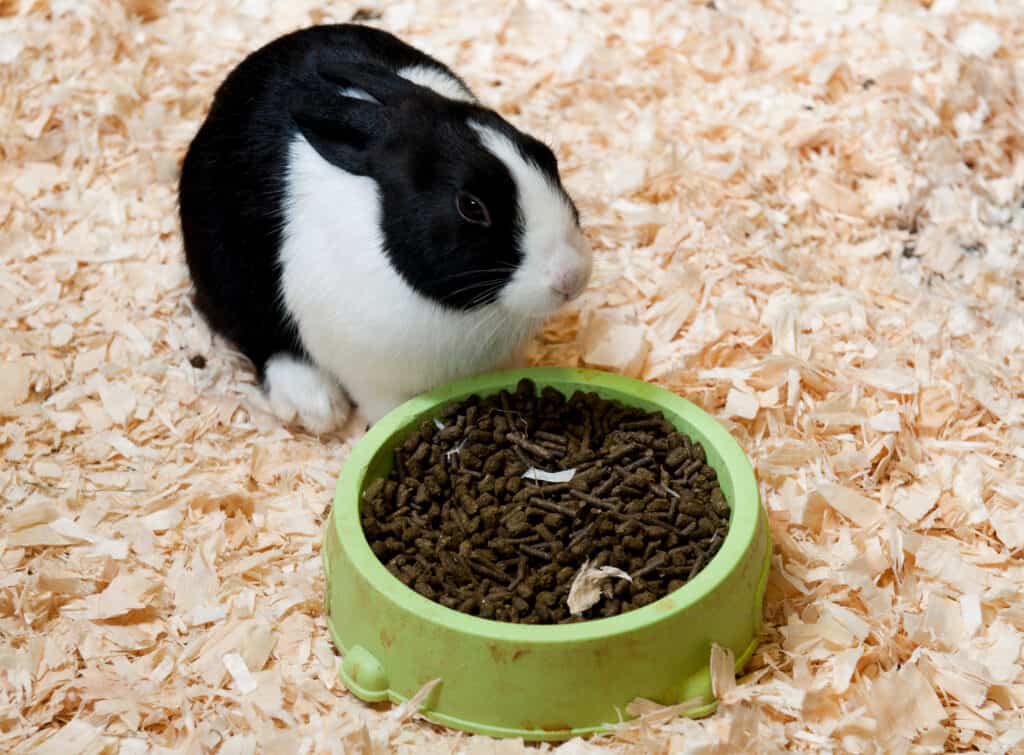
While 90% of the Dutch rabbit’s diet is hay, it can be supplemented with pellets and fresh fruit and vegetables.
©Luis Santos/Shutterstock.com
The ideal diet for a pet rabbit includes:
- 80% grass hay
- 5% healthy pellets
- 10% veggies
- 5% fruit, herbs, and treats
Because of the varied diet, the costs of their food will vary significantly on your area and access to fresh produce and grass hay. For their veggies and fruits, you may want to consider growing your own plants in a rabbit-proof indoor greenhouse or outdoor plot.
Bunnies need unlimited 24-hour access to their clean water and hay but should have limited access to the pellets, produce, and treats. They both tend to overeat and have a vulnerability to bacteria that build up in their stomachs if they don’t maintain food in their digestive systems. Proper fiber from the hay also helps prevent the overgrowth of their teeth. Ration out things like pellets and treats more stringently than the produce but keep even that limited.
Overall, most folks spend between $35 and $60 per month on pellets, produce, and hay for their bunnies.
Cost for Toys
While chewing for bunnies is a necessity to keep their long teeth in healthy shape, they also thoroughly enjoy the act. So, to keep your bunny healthy and happy, they need things to chew on. To keep you happy, chew toys designed for your rabbit are the best choice. Otherwise, they’ll chew on your electronic cables, furniture, and more.
An initial purchase of about $20 worth of toys may well do the trick, though you’ll need to add more toys along the way. Most folks spend between $20 annually on toys to keep things interesting for their fluffy-tailed pals.
Cost for Playpen
Enclosures that allow rabbits more space are important. These may be outdoors or indoors, with their hutches included. They aren’t absolutely necessary, but they will help reduce the damage rabbits cause to other things, like furniture. Most playpens run around $70 to $100.
Cost for Litter Box
Your rabbit needs a litter box to do her business. You can purchase one easily for around $5 to $10. They don’t need anything fancy.
Cost for Litter
Of course, they also need litter for those litter pans. They also have particularly strong-smelling urine, so regularly changing out the litter is necessary as well. Litter generally runs from $5 to $50 a month, depending on what you use. Make sure the litter you choose is rabbit-safe.
Cost of Hay Feeder
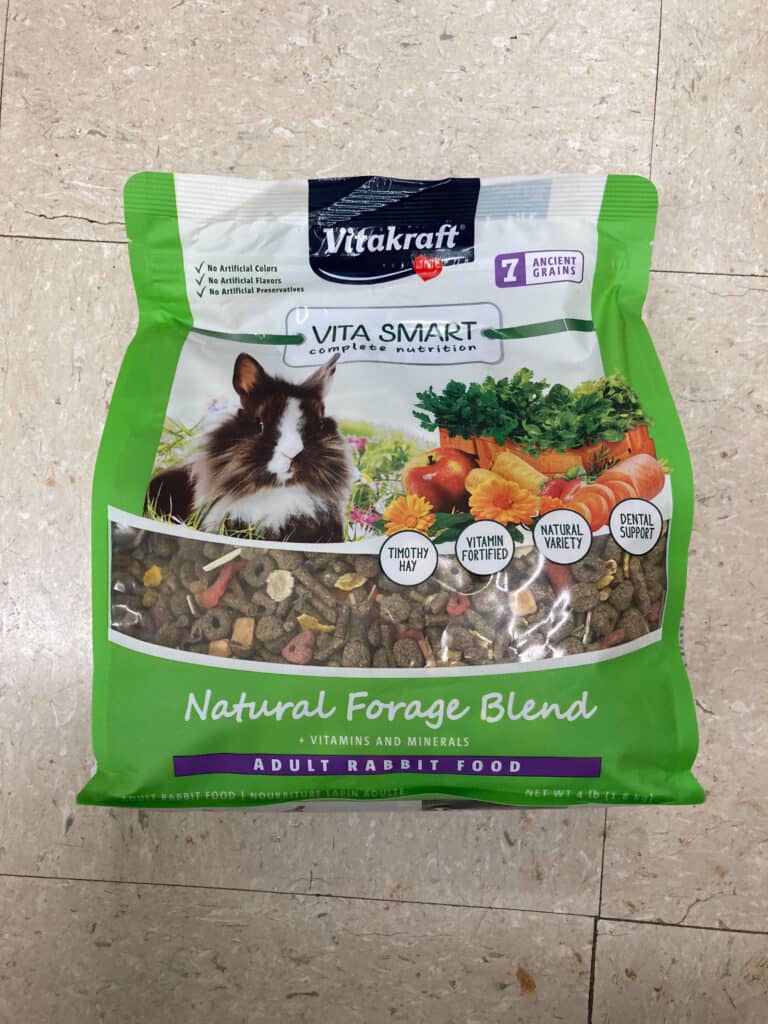
The easiest way to keep hay clean for your rabbit’s constant access is via a hay feeder. These usually cost between $50 and $100.
Cost for Food Bowls
Whether you opt for two bowls for the water and food or a bottle and a bowl, you’ll likely spend between $10 and $35 for these.
Cost for Nail Clippers
Unless you plan to take your rabbit to the groomer all the time, you’ll need a good pair of clippers. Their claws grow rapidly and need to be trimmed often. A pair of clippers costs about $5 to $10 and will save you hundreds in groomer fees.
Cost of Cleaning Supplies
You’ll need to regularly clean out your rabbit’s food and water containers, as well as the litter box, hutch, and play areas. This means rabbit-safe cleansers come into play regularly. It doesn’t have to be expensive, though, particularly if you save the specific cleanser for just the rabbit’s terrain. Generally, a proper cleaner will cost about $5 to $10 per bottle, which amounts to less than $2 a month in most cases.
Total Costs of Bringing Home a Rabbit
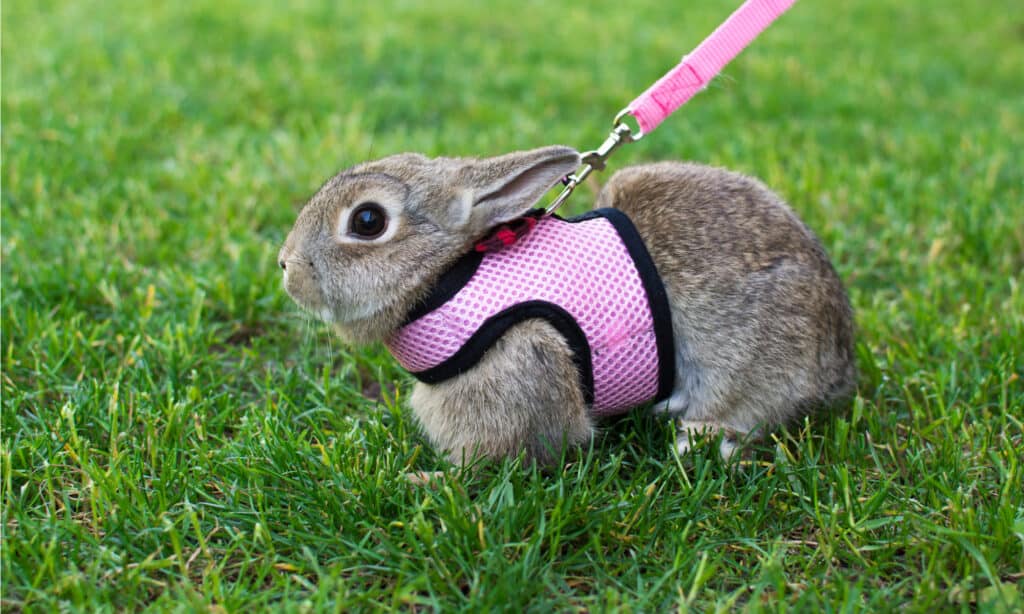
If you want to make your bunny an indoor/outdoor pet, you may be able to train her to a harness so you can take walks together safely.
©MJfotografie.cz/Shutterstock.com
- Rabbit adoption/fee $20 — $250
- Hutch and cage $200 — $300
- Insurance $20 — $35
- Spay/neuter $125 — $250
- Playpen $70 — $100
- Food $35 — $60
- Toys $20 — $35
- Litter box $5 — $10
- Litter $5 — $50
- Hay feeder $50 — $100
- Food and water bowls/bottles $10 — $35
- Nail clippers $5 — $10
- Cleaning supplies $5 — $10
In total, you’re looking at $570 to $1245 to bring home a rabbit and all their initial equipment.
Monthly Costs for a Rabbit
Once you bring your furry pal home, the monthly costs will likely run you between $80 and $132 monthly for food, toys, litter, cleaning, and other normal upkeep.
Helpful and Fun Facts About Rabbits
- Rabbits may live up to 10 years in captivity.
- To express their joy, rabbits may do a large jump and then flick motion. This is known as a binky.
- Many folks don’t know what a rabbit sounds like. Yet, they are not the quietest pet you could have. They growl, grumble, whine, screech, chatter their teeth, and honk. If they’re frightened, they may even scream. You may even hear a happy bunny purring about its contentment.
- Rabbits use their long ears to hear and to help regulate their body temperature. The blood vessels swell in the heat and contract when it’s cold out.
- Female rabbits are known as does, while males are called bucks. Young rabbits are called kittens, kitties, or kits.
- Rabbits may rotate their ears up to 270 degrees to better assess the noises around them.
- These floppy-eared critters may jump up to 3 feet high and 10 feet long — making the need for large, tall cages necessary for your pets!
- Not all rabbits love fruit. But one with a sweet tooth adores the stuff! Be sure to keep fruit levels moderate, though, as the sugar content is a lot for such a small animal.
- Their sensitive digestive systems keep rabbits from vomiting. And while that makes clean-up easier (i.e., no vomit like with cats), it does mean they are super sensitive to their diet and environment. It’s critical that you keep their pellets and produce, as well as unhealthy things out of reach for their safety.
The photo featured at the top of this post is © Diana Sklarova/Shutterstock.com
Thank you for reading! Have some feedback for us? Contact the AZ Animals editorial team.




